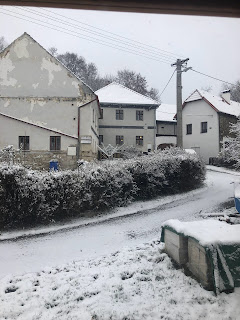I apologise for the gap in posts. You must have thought I had given up on this blog, and maybe I had. Maybe having sold the house and been confined to the UK by Covid, bad knees and back it hurt too much to look at what I had lost/been forced to give up. It did and does hurt.
In November 2022 I did return to my little Czech village, staying in the house of my puppetmaker friend directly opposite my old home. It felt very strange to cross the bridge across her drainage moat and look at the bright lights shining out from my old home. In the November gloom the house was a beacon on the lower slopes of the Lisci Dira hill. I saw it as I crowned the hill on the track I took on my walk home from the bus, calling me down to the village and yet not calling me, because it was nolonger mine.
In the house someone else was stoking the stove, someone else was chopping onions and making goulash, someone else was talking to her friends. Someone else but not me.





















